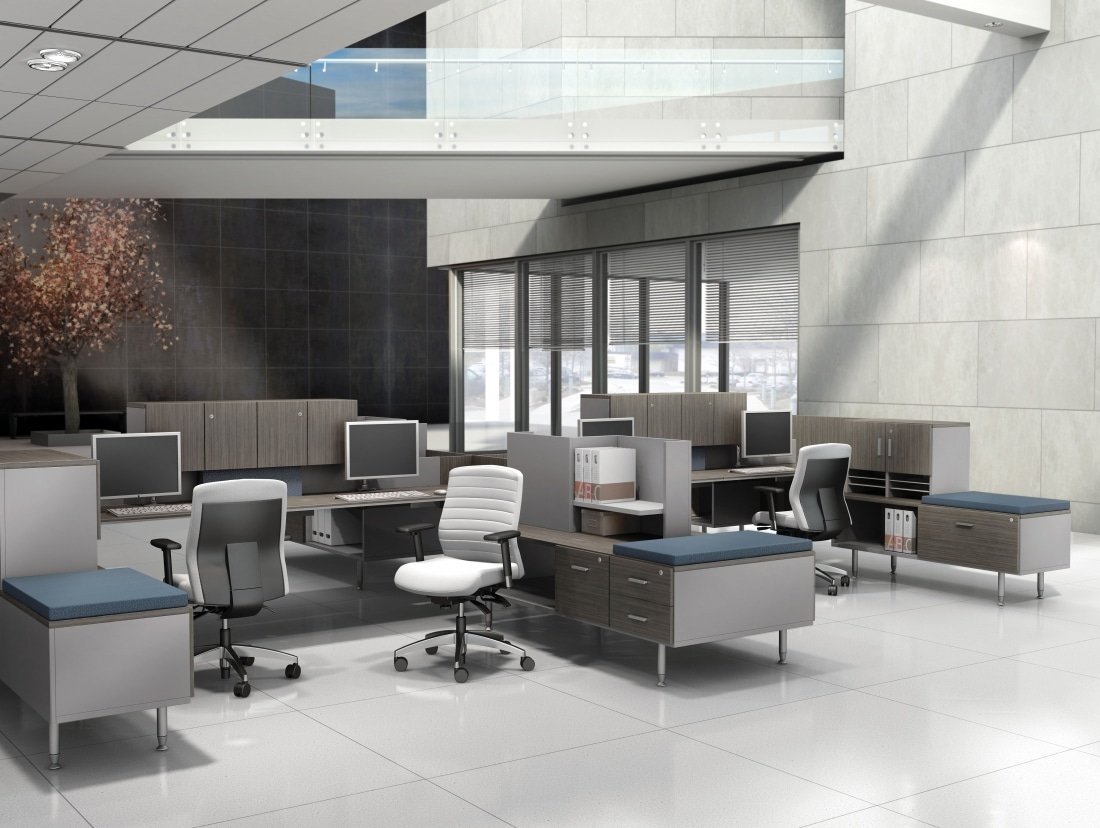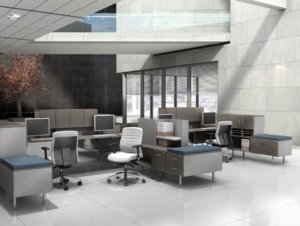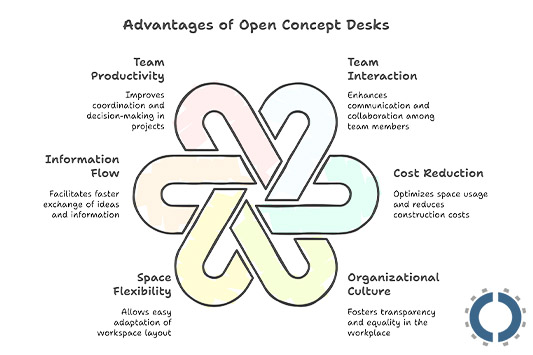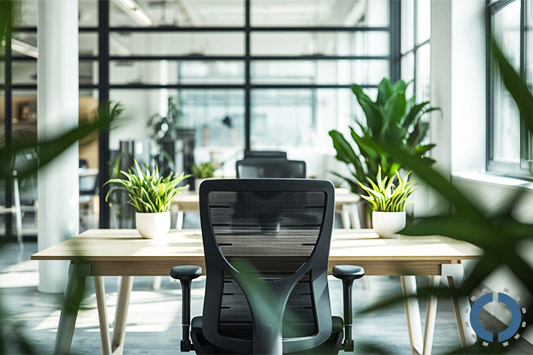Why Are Open Concept Desks Good for Startups?

Open concept desks can be for more than individual work. Cubicles and other segregated desks discourage collaboration and nurture competition instead of teamwork. The result is a strenuous work environment that benefits neither employees nor the company.
Startup culture thrives on collaboration and teamwork, and open workspaces are ideal for fostering that culture. When someone needs a quick conversation with a team member, the ideal scenario is not walking to another room.
 It provides the ability to sit down at their teammate’s desk, solving the problem together, then getting back to their work. More time spent moving is less time spent working on your startup’s goals.
It provides the ability to sit down at their teammate’s desk, solving the problem together, then getting back to their work. More time spent moving is less time spent working on your startup’s goals.
Still not convinced? (Or maybe you just like reading about desks.) Okay, let’s go more in-depth.
Eleven Ways an Open Concept Desk Will Benefit Your Startup
1. Increases Collaboration
Open concept desks enable employees to sit near coworkers with other jobs, allowing them to learn more than just their specific tasks.
Many offices shift employees’ seats, so they are exposed to different functions of the business. This enhances the perspective of the workforce as they gain insight into various business functions. One of the many reasons startups prefer open concepts is that they can be a source of new and innovative ideas.
2. Creates a Melting Pot for New Ideas
Working alongside others with different jobs and different backgrounds will bring a fresh perspective to your work. There will be times when your teammates can look at the challenges you face and approach them from unexpected angles. Equally, you can bring fresh insight to others’ problems as well.
An open concept workspace that encourages idea-sharing benefits the entire company. In the end, the whole should always be greater than the sum of its parts.
3. Enhanced relationships and interactions
When people collaborate and learn from others, it reduces the monotony of daily work. The interactions in an open office are far greater than in an office with cubicles and walls. This can lead to team building and be reflected in the work they do. Team members can identify each other’s strengths, then divide tasks in a way that decreases the overall effort, maximizing productivity.
4. Teamwork Instead of Competition
Be it intentional or not, too many of today’s workplaces value the individual over the group. This is apparent in the way most businesses are structured. Even startups commonly practice ranking workers and rewarding individual talent, which inadvertently encourages employees to compete against each other. The result is a culture that cannibalizes itself rather than working toward a common goal. Enter office politics, stage left.
Open concept desks give teams the chance to work with each other and endeavor to achieve common goals and objectives. Moreover, these types of office environments foster friendships and camaraderie within the workplace.
5. Improved Mental Health
Workspaces that foster collaboration show decreased stress and depression at the same time, boosting overall moods in the workplace. In today’s anxious and stressful world, it’s essential to cultivate meaningful relationships both at work and at home.
6. Increased Energy
A career spent staring at the four small corners of an office or cubicle can drain you of your drive and motivation. To regain your energy, work with others. With open concept desks, employees can motivate one another and benefit from the fast-paced and motivated environment of typical startup culture.
 Working alongside like-minded people will rekindle your drive, giving you an emotional boost. So, instead of spending your workday confined to a tiny box, spend your time working with and beside other motivated professionals.
Working alongside like-minded people will rekindle your drive, giving you an emotional boost. So, instead of spending your workday confined to a tiny box, spend your time working with and beside other motivated professionals.
7. Inexpensive Compared to the Alternative
From an employer’s perspective, buying 50 standing desks is considerably cheaper than setting up 50 cubicles. Beyond the cost of construction, you end up using office space to its maximum potential.
An office cubicle costs five to six times that of an open concept workstation and requires space that could seat two to four employees at an open concept desk system.
8. Flexibility
If you have available space, it is simpler to expand and rearrange when using open concept desks, as you only have to add another desk or move things around.
When using cubicles, however, they must be torn down to move around and constructed to add more.
9. Eliminates boundaries between staff
In the hierarchical structure, you must set an appointment to converse with senior management, but in an open office, you eliminate those boundaries. There is no wasted time walking between offices since everyone is in the same area.
 You may even be sitting next to your boss. While this advantage doesn’t always make a considerable difference in the welfare of a company, it could save employees some time and frustration throughout the day. When employees are in a closed office space, they can waste time with small tasks that a team could have completed with minimal effort.
You may even be sitting next to your boss. While this advantage doesn’t always make a considerable difference in the welfare of a company, it could save employees some time and frustration throughout the day. When employees are in a closed office space, they can waste time with small tasks that a team could have completed with minimal effort.
10. Conducive to Productivity and Efficiency
Collaborative environments have been shown to bring out the best in people and groups. In a study completed by the Harvard Business Review regarding thriving at the workplace, Employees who worked in collaborative spaces scored 6 out of a possible 7 points – higher than their counterparts confined to cubicles. It’s no mystery why companies are more often thinking outside the box – and outside the cubicle!
11. Consolidated Supervision
Because all the workers are in the same space, it is much easier to supervise as leaders are in continuous contact with the employees. This also allows dealing with issues faster.
Benefits of Open Concept Desks
Open concept desks in startup workspaces provide several practical and cultural benefits for teams:
1. Increase Team Interaction
By removing dividers and walls in offices and creating an open design, team members communicate more easily with each other, and ideas are transferred more quickly.
This continuous interaction strengthens collaboration and increases creativity in projects.
2. Cost Reduction
Using shared, open desks reduces the need to build separate rooms and cubicles and optimizes office space.
This is an important advantage, especially for startups with limited budgets.
3. Improving Organizational Culture
Open space fosters a sense of transparency and equality in the workplace and helps create a collaborative and open organizational culture.
Employees feel closer to each other, and the work environment becomes more engaging and dynamic.
4. Increasing Flexibility in Space
One of the most important features of open concept desks is the high flexibility in layout.
These office desks are usually designed modularly and can be easily moved or changed to accommodate team setups.
This flexibility allows startups to easily adapt their workspace structure as the team grows or projects change, without the need for a complete office redesign.
5. Improve Information Flow and Creativity
In open workspaces, information is exchanged faster between team members.
Removing physical and visual barriers allows for more informal communication, conversations that often lead to innovative ideas and faster problem-solving.
6. Increasing Team Productivity in Projects
Coordination on projects is easier when teams work closely together.
Members can provide feedback or make collective decisions more quickly.
This is especially important in dynamic and multi-tasking startup projects.
Challenges and Solutions in Using Open Concept Desks
Despite all the benefits that open concept desks bring to startups, their potential challenges should not be overlooked.
Open design, if implemented without proper planning and understanding of the team’s needs, can lead to reduced focus and employee dissatisfaction.
Below, we examine the most important challenges and their solutions.
1. Lack of Privacy
One of the main concerns in open workspaces is the lack of sufficient privacy.
When people work together without any obstacles, it becomes difficult to maintain focus, and the feeling of mental security decreases.
This is especially problematic for tasks that require high concentration or confidential conversations.
To solve this problem, short partitions, transparent demountable walls, or natural green screens can be used between tables to create privacy while maintaining visual connection.
Also, having small rooms for meetings or private calls creates a good balance between open space and individual needs.
 2. Increased Noise and Distractions
2. Increased Noise and Distractions
Noise is another serious challenge in open concept design.
Group discussions, phone calls, and commuting can disrupt employee focus, resulting in reduced productivity.
To manage this problem, using sound-absorbing materials in the ceiling and floor, and even in office furniture Houston, can be effective.
Setting behavioral rules to reduce noise, such as limiting calls to the main space or using noise-canceling headphones, can also help maintain focus.
Some companies even create “quiet” areas where employees can do more detailed work.
3. Differences in work styles
Every team has people with different working styles.
Some people are energized and more creative in open spaces, while others function better in silence and solitude.
Implementing a uniform design for everyone can lead to dissatisfaction and reduced productivity.
The best solution is to create hybrid spaces, that is, an environment that has areas for group collaboration and areas for individual focus.
With this method, employees have more freedom to choose a work environment that suits their duties and gain a greater sense of satisfaction and commitment to the workplace.
What is best for you?
Knowing the advantages and disadvantages of an open concept office is critical.
The decision will ultimately boil down to the nature of your business, office culture, values, and most importantly, your employees.
Even if the nature of your business is not conducive to an open concept office (the need for privacy, dealing with sensitive information, the need for intense focus), many offices have found great benefit in having a space for collaboration. Having open concept desks for employees to use when not dealing with private issues or needing great focus can be beneficial for all the reasons listed above.

John Ofield is the owner of Collaborative Office Interiors. Houston’s trusted source for modern and commercial office furniture, office cubicles, demountable walls, office desks and tables, and complete workspace solutions. With more than 40 years of experience, he combines deep product knowledge with hands-on space-planning expertise to create ergonomic, productivity-focused work environments for businesses across Southeast Texas.


 2. Increased Noise and Distractions
2. Increased Noise and Distractions
